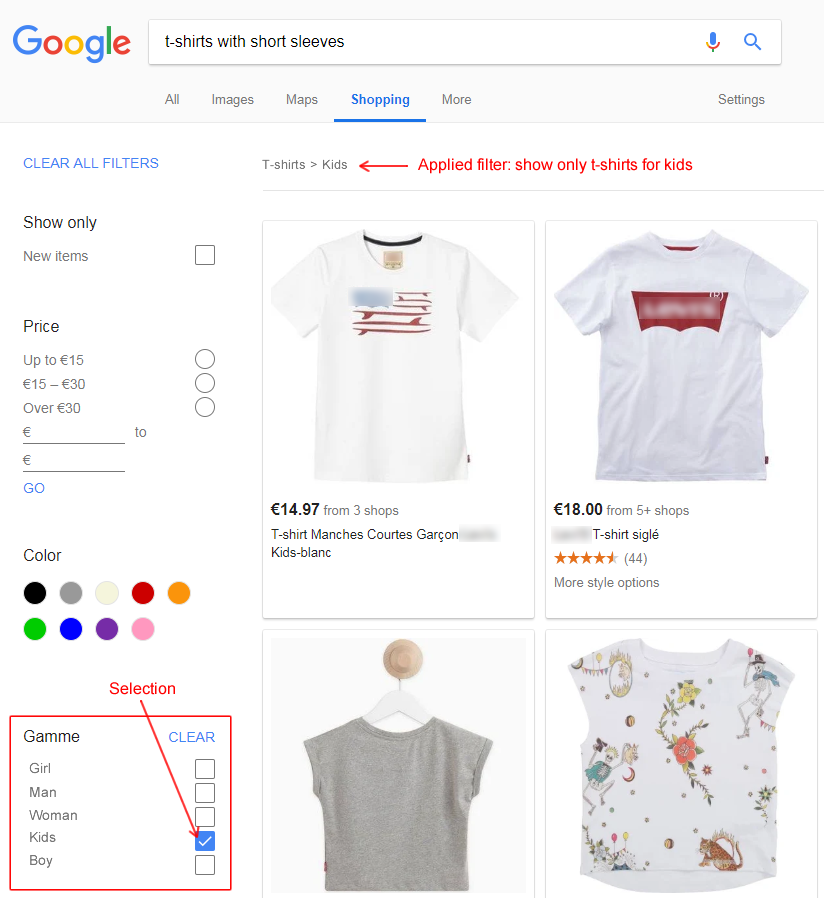Is it necessary to indicate an age group for using my products?
By indicating in your data feed the age group for which your products or product combinations are designed for, this allows Google to apply accurate filters that users can use to narrow search results.
You will therefore take advantage of an advanced ranking in Google Shopping. Indeed, the Google Shopping layered navigation allows the users to select, for example, only one demographic. By providing the information about age groups for which your products are designed for, you will be able to appear in selections by demographic.
Example: let's imagine that a Google Shopping user enter the "t-shirt with short sleeves" keywords in the Google Shopping search engine and then select the "Kids" demographic in the left menu. If you sell t-shirts with short sleeves for kids and if you have indicated in your feed that you sell products for kids, your t-shirts will appear in the selection. Also, it is interesting to note that you can benefit from an even more accurate filtering on your products by giving information on gender (female or male). In this way the user who wants to see short-sleeved t-shirts for "girl" kids will have even more chance to see your products by clicking on the filter "girl" which is even more accurate because it takes into account the age AND sex.
In a general way, keep in mind that the more information you will provide about your products to Google, the better your feed will be and the better your products ranking will be in Google Shopping.

The age group must be provided for all products that belongs to the Google category: Apparel & Accessories (166) and whose feed targets certain countries (which list is available by clicking here), including France and United States. It is also required for all products with assigned age groups, even if they are not clothing or accessories and whatever the targeted country.
However, the age group is optional for some products in the Google "Apparel & Accessories". You will find the list of these exceptions by clicking here.
Also, even if your products don't match with the conditions above, we advise you to indicate the age groups for which your products are designed for, anyway. Indeed, the more information you will provide about your products to Google, the better your feed will be and the better your product ranking will be in Google Shopping.
Please read the Google's official guidelines about the "age-group" tag in Google Shopping attentively by clicking here.
The "age group" information is especially useful (mandatory) for apparel, so this is why its configuration in the module is available in the "Apparel feed options" tab of the "Feed management" section. However, as said previously, the age group information may also be needed for other product types.
To configure the "age group" tag for each of your default categories, select "Yes" for the "Do you want to include age group tags?" option, save and then click "configure the tag for each category" :

You get a pop-up that lists all your categories(*). Indicate what group of age the products of each category are matching with. Several values are available :
- Adult (typically teens or older)
- Kids (5-13 years old)
- Toddler (1-5 years old)
- Infant (3-12 months old)
- Newborn (up to 3 months old)
(*)Warning : please note that the categories we are talking about are the DEFAULT categories.

Finally click "Modify" and don't forget to save the "Apparel feed options" form.
Other FAQs in this category
- How to indicate the dimensions of my packages?
- Do I need to indicate the size system used for my products?
- Do I have to indicate the gender for which my products are made?
- How to send quality images to Google Shopping?
- How to indicate a package weight unit that complies with Google's requirements?
- Do I need to indicate the size type of my products?
- Do I have to provide information about my product patterns?
- Do I have to provide information about my product material?
- Do I have to provide product colors in the feed?
- Do I have to include product sizes in the feed?
- What are the Google's requirements for product description?
- What are the guidelines for quality product titles?